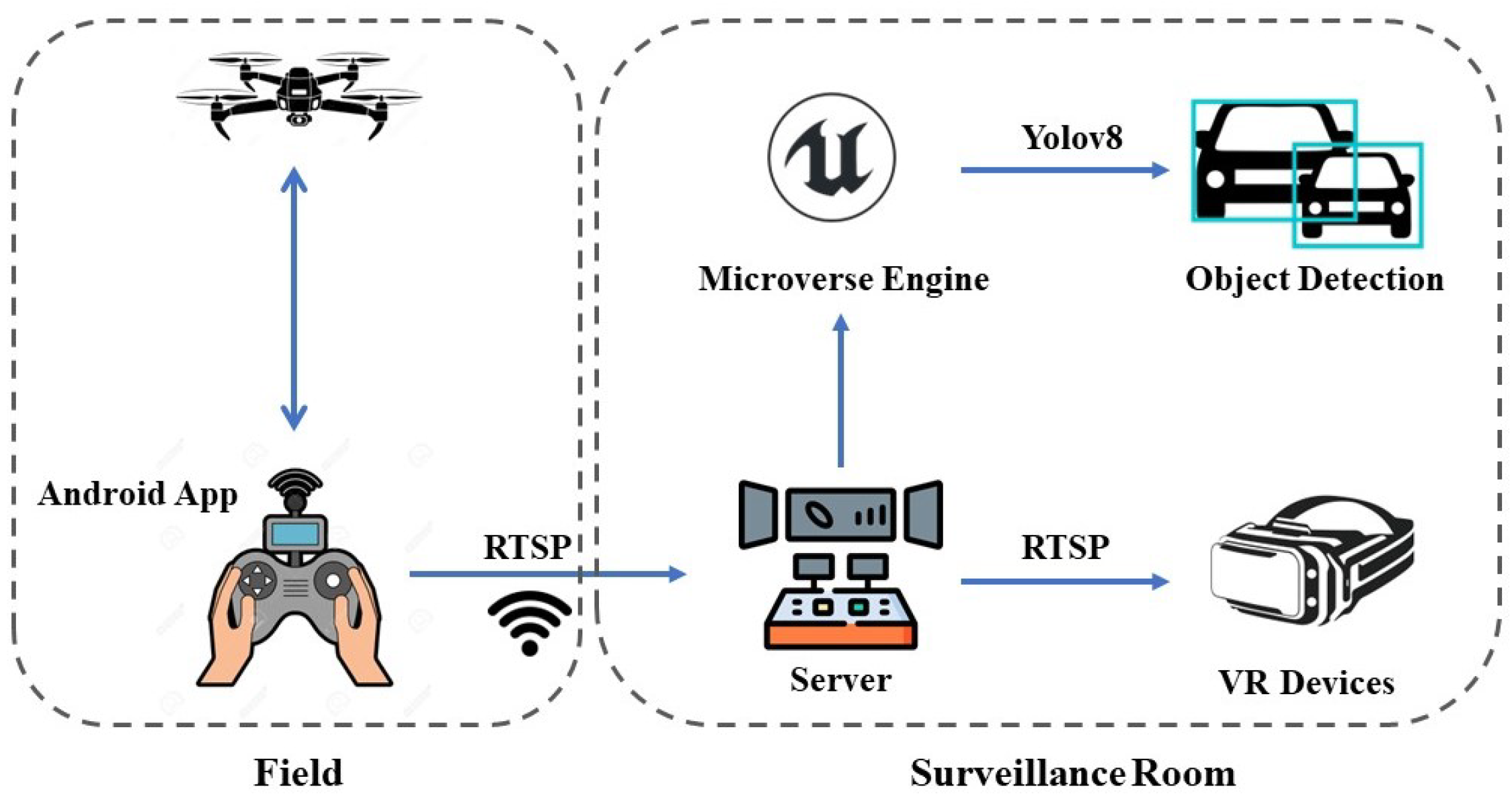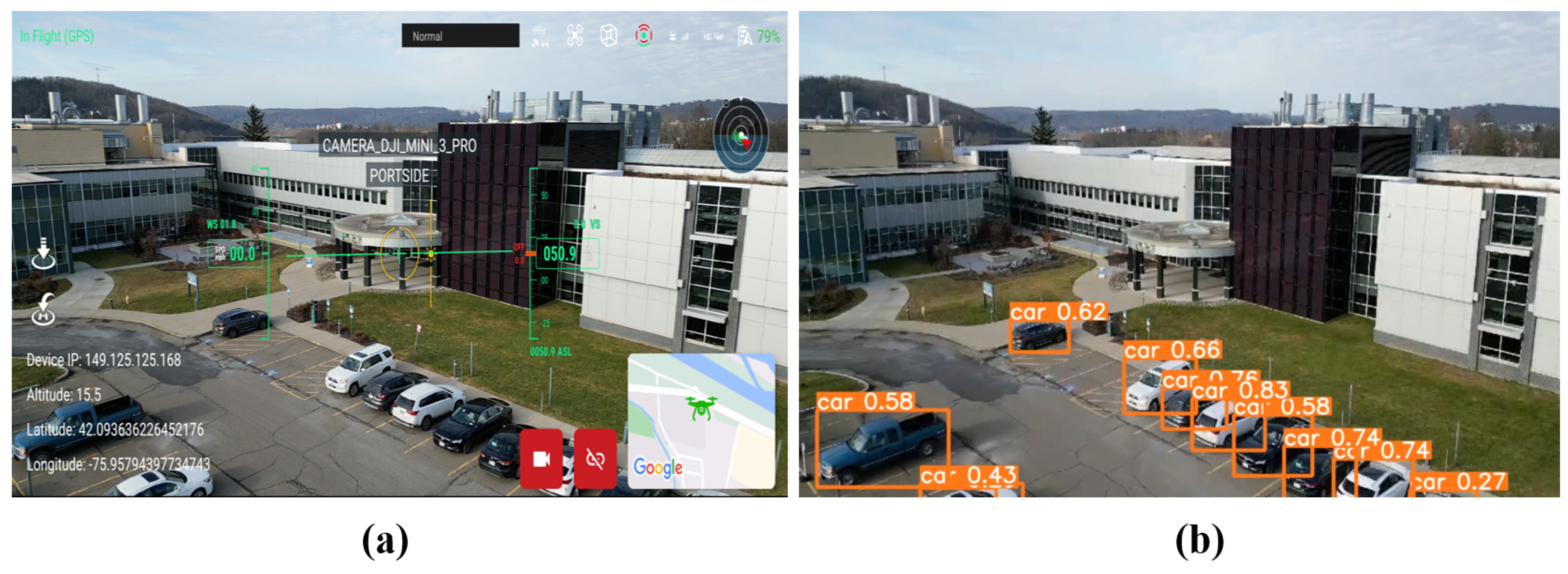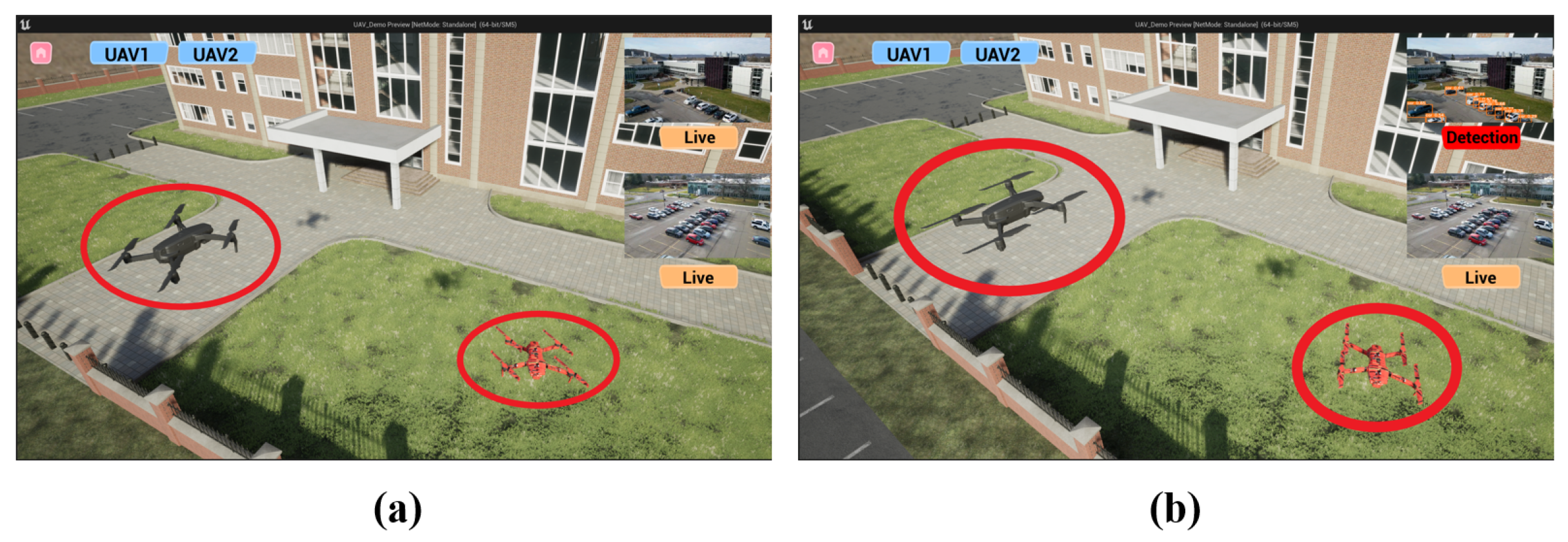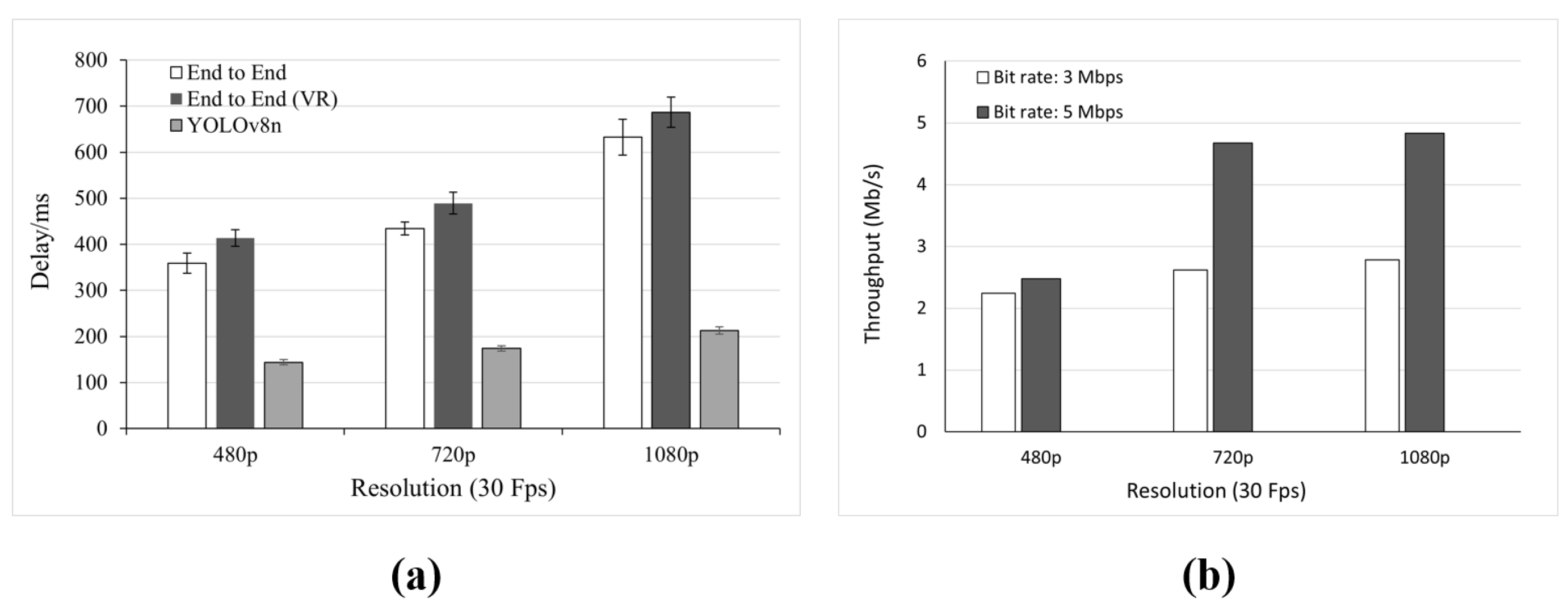The Microverse: A Task-Oriented Edge-Scale Metaverse
Abstract
1. Introduction
- A hierarchical microverse framework is proposed. The microverse approach redefines the metaverse into a dynamic, purpose-built ecosystem that streamlines task completion, enhances collaboration, and offers immersive professional settings.
- Using smart public safety surveillance (SPSS) for smart communities as a case study, a microverse instance is designed and created that contains unmanned aerial vehicles (UAVs), ground units, and sensing networks. Leveraging technologies such as DTs and AI, the SPSS prototype mirrors objects in virtual space and is capable of surveillance tasks.
- The feasibility of the microverse is validated through a preliminary experimental study on the proof-of-concept prototype of the SPSS microverse system in which we are continuously constructing the microverse for further research.
2. Background and Related Work
2.1. The Metaverse in the IoT: Challenges
2.2. Digital Twins
2.3. Network Slicing
2.4. Lightweight Blockchain
3. The Microverse: Rationale and Architecture
3.1. A Hierarchical Architecture View
3.2. Microchained IoT Networks
3.3. The Microverse: A Task-Oriented Metaverse
4. Case Study: A Smart Public Safety Surveillance Microverse for Smart Communities
4.1. Design Rationale
4.2. SPSS Microverse Prototype Architecture
4.3. Workflow and System Settings
4.4. Experimental Results
4.5. Discussion
5. Conclusions and Future Work
Author Contributions
Funding
Institutional Review Board Statement
Data Availability Statement
Acknowledgments
Conflicts of Interest
Abbreviations
| AI | Artificial intelligence |
| AR | Augmented reality |
| CCTV | Closed-circuit television |
| DDDAS | Dynamic data-driven applications systems |
| DL | Deep learning |
| DLT | Distributed ledger technology |
| DT | Digital twin |
| EPDS | Electric propulsion drive system |
| FPV | First-person view |
| HLS | HTTP live streaming |
| HPP | High-precision product |
| IoST | Internet of Smart Things |
| IoT | Internet of Things |
| JSON | JavaScript Object Notation |
| ML | Machine learning |
| mMTC | Massive machine-type communication |
| MSPSS | Microverse SPSS |
| NASA | National Aeronautical and Space Administration |
| NIST | National Institute of Standards and Technology |
| NS | Network slicing |
| P2P | Peer-to-peer |
| PBFT | Practical Byzantine fault tolerance |
| PC | Personal computer |
| PoS | Proof of stake |
| PoW | Proof of work |
| QoS | Quality of Service |
| RTMP | Real-Time Messaging Protocol |
| RTSP | Real-Time Streaming Protocol |
| SL | Slicing layer |
| SPSS | Smart public safety surveillance |
| UAM | Urban air mobility |
| UAV | Unmanned aerial vehicle |
| UE5 | Unreal Engine 5 |
| UI | User interface |
| URLLC | Ultrareliable low-latency communication |
| WLAN | Wireless local area network |
| VR | Virtual reality |
| XR | Extended reality |
References
- Xu, R.; Nikouei, S.Y.; Chen, Y.; Blasch, E.; Aved, A. Blendmas: A blockchain-enabled decentralized microservices architecture for smart public safety. In Proceedings of the 2019 IEEE International Conference on Blockchain (Blockchain), Atlanta, GA, USA, 14–17 July 2019; IEEE: Piscataway, NJ, USA, 2019; pp. 564–571. [Google Scholar]
- Global Community Technology Challenge. Available online: https://www.nist.gov/ctl/smart-connected-systems-division/iot-devices-and-infrastructures-group/smart-americaglobal-0 (accessed on 26 December 2023).
- Lai, C.M.T.; Cole, A. Measuring progress of smart cities: Indexing the smart city indices. Urban Gov. 2023, 3, 45–57. [Google Scholar] [CrossRef]
- Wu, Y.; Dai, H.N.; Wang, H.; Xiong, Z.; Guo, S. A survey of intelligent network slicing management for industrial IoT: Integrated approaches for smart transportation, smart energy, and smart factory. IEEE Commun. Surv. Tutor. 2022, 24, 1175–1211. [Google Scholar] [CrossRef]
- Xu, R.; Chen, Y.; Li, X.; Blasch, E. A secure dynamic edge resource federation architecture for cross-domain IoT systems. In Proceedings of the 2022 International Conference on Computer Communications and Networks (ICCCN), Honolulu, HI, USA, 25–28 July 2022; IEEE: Piscataway, NJ, USA, 2022; pp. 1–7. [Google Scholar]
- Kusuma, A.T.; Supangkat, S.H. Metaverse fundamental technologies for smart city: A literature review. In Proceedings of the 2022 International Conference on ICT for Smart Society (ICISS), Bandung, Indonesia, 10–11 August 2022; IEEE: Piscataway, NJ, USA, 2022; pp. 1–7. [Google Scholar]
- Cheng, R.; Wu, N.; Chen, S.; Han, B. Will metaverse be nextg internet? vision, hype, and reality. IEEE Netw. 2022, 36, 197–204. [Google Scholar] [CrossRef]
- Cheng, R.; Wu, N.; Varvello, M.; Chen, S.; Han, B. Are we ready for metaverse? A measurement study of social virtual reality platforms. In Proceedings of the 22nd ACM Internet Measurement Conference, Nice, France, 25–27 October 2022; pp. 504–518. [Google Scholar]
- Mozumder, M.A.I.; Sheeraz, M.M.; Athar, A.; Aich, S.; Kim, H.C. Overview: Technology roadmap of the future trend of metaverse based on IoT, blockchain, AI technique, and medical domain metaverse activity. In Proceedings of the 2022 24th International Conference on Advanced Communication Technology (ICACT), Pyeongchang, Republic of Korea, 13–16 February 2022; IEEE: Piscataway, NJ, USA, 2022; pp. 256–261. [Google Scholar]
- Jha, M.K.; Yogeshwari, A.; Rubini, P.; Singh, M. Converge of IoT and AI in Metaverse: Challenges and Opportunities. In Proceedings of the 2023 5th International Conference on Inventive Research in Computing Applications (ICIRCA), Coimbatore, India, 3–5 August 2023; IEEE: Piscataway, NJ, USA, 2023; pp. 1462–1467. [Google Scholar]
- Lin, H.; Wan, S.; Gan, W.; Chen, J.; Chao, H.C. Metaverse in education: Vision, opportunities, and challenges. In Proceedings of the 2022 IEEE International Conference on Big Data (Big Data), Osaka, Japan, 17–20 December 2022; IEEE: Piscataway, NJ, USA, 2022; pp. 2857–2866. [Google Scholar]
- Yaqoob, I.; Salah, K.; Jayaraman, R.; Omar, M. Metaverse applications in smart cities: Enabling technologies, opportunities, challenges, and future directions. Internet Things 2023, 23, 100884. [Google Scholar] [CrossRef]
- Ismail, L.; Buyya, R. Metaverse: A Vision, Architectural Elements, and Future Directions for Scalable and Realtime Virtual Worlds. arXiv 2023, arXiv:2308.10559. [Google Scholar]
- Jaimini, U.; Zhang, T.; Brikis, G.O.; Sheth, A. iMetaverseKG: Industrial Metaverse Knowledge Graph to Promote Interoperability in Design and Engineering Applications. IEEE Internet Comput. 2022, 26, 59–67. [Google Scholar] [CrossRef]
- Rawal, B.S.; Mentges, A.; Ahmad, S. The Rise of Metaverse and Interoperability with Split-Protocol. In Proceedings of the 2022 IEEE 23rd International Conference on Information Reuse and Integration for Data Science (IRI), San Diego, CA, USA, 9–11 August 2022; IEEE: Piscataway, NJ, USA, 2022; pp. 192–199. [Google Scholar]
- Aloqaily, M.; Bouachir, O.; Karray, F.; Al Ridhawi, I.; El Saddik, A. Integrating digital twin and advanced intelligent technologies to realize the metaverse. IEEE Consum. Electron. Mag. 2022, 12, 47–55. [Google Scholar] [CrossRef]
- Blasch, E.; Pham, T.; Chong, C.Y.; Koch, W.; Leung, H.; Braines, D.; Abdelzaher, T. Machine learning/artificial intelligence for sensor data fusion–opportunities and challenges. IEEE Aerosp. Electron. Syst. Mag. 2021, 36, 80–93. [Google Scholar] [CrossRef]
- Grieves, M.; Vickers, J. Digital twin: Mitigating unpredictable, undesirable emergent behavior in complex systems. In Transdisciplinary Perspectives on Complex Systems: New Findings and Approaches; Springer: Cham, Switzerland, 2017; pp. 85–113. [Google Scholar]
- Park, K.T.; Yang, J.; Noh, S.D. VREDI: Virtual representation for a digital twin application in a work-center-level asset administration shell. J. Intell. Manuf. 2021, 32, 501–544. [Google Scholar] [CrossRef]
- Malik, A.A.; Brem, A. Digital twins for collaborative robots: A case study in human-robot interaction. Robot. Comput. -Integr. Manuf. 2021, 68, 102092. [Google Scholar] [CrossRef]
- Bilberg, A.; Malik, A.A. Digital twin driven human–robot collaborative assembly. CIRP Ann. 2019, 68, 499–502. [Google Scholar] [CrossRef]
- Maruyama, T.; Ueshiba, T.; Tada, M.; Toda, H.; Endo, Y.; Domae, Y.; Nakabo, Y.; Mori, T.; Suita, K. Digital twin-driven human robot collaboration using a digital human. Sensors 2021, 21, 8266. [Google Scholar] [CrossRef]
- Sun, X.; Bao, J.; Li, J.; Zhang, Y.; Liu, S.; Zhou, B. A digital twin-driven approach for the assembly-commissioning of high precision products. Robot. Comput. -Integr. Manuf. 2020, 61, 101839. [Google Scholar] [CrossRef]
- Karadeniz, A.M.; Arif, İ.; Kanak, A.; Ergün, S. Digital twin of eGastronomic things: A case study for ice cream machines. In Proceedings of the 2019 IEEE International Symposium on Circuits and Systems (ISCAS), Sapporo, Japan, 26–29 May 2019; IEEE: Piscataway, NJ, USA, 2019; pp. 1–4. [Google Scholar]
- Rassõlkin, A.; Vaimann, T.; Kallaste, A.; Kuts, V. Digital twin for propulsion drive of autonomous electric vehicle. In Proceedings of the 2019 IEEE 60th International Scientific Conference on Power and Electrical Engineering of Riga Technical University (RTUCON), Riga, Latvia, 7–9 October 2019; IEEE: Piscataway, NJ, USA, 2019; pp. 1–4. [Google Scholar]
- Hu, Z.; Lou, S.; Xing, Y.; Wang, X.; Cao, D.; Lv, C. Review and perspectives on driver digital twin and its enabling technologies for intelligent vehicles. IEEE Trans. Intell. Veh. 2022, 7, 417–440. [Google Scholar] [CrossRef]
- Darema, F. New software architecture for complex applications development and runtime support. Int. J. High Perform. Comput. Appl. 1999, 13, 180–190. Available online: https://journals.sagepub.com/doi/abs/10.1177/109434209901300302?download=true&journalCode=hpcc (accessed on 2 February 2024).
- Bazilevs, Y.; Korobenko, A.; Deng, X.; Tippmann, J.; Hsu, M.C. Wind turbine simulation: Structural mechanics, fsi and computational steering. In Proceedings of the COUPLED V: Proceedings of the V International Conference on Computational Methods for Coupled Problems in Science and Engineering:. CIMNE, Ibiza, Spain, 17–19 June 2013; pp. 229–240. [Google Scholar]
- Pérez, E. A Simulation-Based Online Dynamic Data-Driven Framework for Large-Scale Wind-Turbine Farm Systems Operation. In Handbook of Dynamic Data Driven Applications Systems: Volume 2; Springer: Berlin/Heidelberg, Germany, 2023; pp. 353–374. [Google Scholar]
- Pargmann, H.; Euhausen, D.; Faber, R. Intelligent big data processing for wind farm monitoring and analysis based on cloud-technologies and digital twins: A quantitative approach. In Proceedings of the 2018 IEEE 3rd International Conference on Cloud Computing and Big Data Analysis (ICCCBDA), Chengdu, China, 20–22 April 2018; IEEE: Piscataway, NJ, USA, 2018; pp. 233–237. [Google Scholar]
- Roda-Sanchez, L.; Cirillo, F.; Solmaz, G.; Jacobs, T.; Garrido-Hidalgo, C.; Olivares, T.; Kovacs, E. Building a Smart Campus Digital Twin: System, Analytics and Lessons Learned from a Real-World Project. IEEE Internet Things J. 2023, 11, 4614–4627. [Google Scholar] [CrossRef]
- Zaballos, A.; Briones, A.; Massa, A.; Centelles, P.; Caballero, V. A smart campus’ digital twin for sustainable comfort monitoring. Sustainability 2020, 12, 9196. [Google Scholar] [CrossRef]
- Erol, T.; Mendi, A.F.; Doğan, D. The digital twin revolution in healthcare. In Proceedings of the 2020 4th International Symposium on Multidisciplinary Studies and Innovative Technologies (ISMSIT), Istanbul, Turkey, 22–24 October 2020; IEEE: Piscataway, NJ, USA, 2020; pp. 1–7. [Google Scholar]
- Elayan, H.; Aloqaily, M.; Guizani, M. Digital twin for intelligent context-aware IoT healthcare systems. IEEE Internet Things J. 2021, 8, 16749–16757. [Google Scholar] [CrossRef]
- Liu, Y.; Zhang, L.; Yang, Y.; Zhou, L.; Ren, L.; Wang, F.; Liu, R.; Pang, Z.; Deen, M.J. A novel cloud-based framework for the elderly healthcare services using digital twin. IEEE Access 2019, 7, 49088–49101. [Google Scholar] [CrossRef]
- Laaki, H.; Miche, Y.; Tammi, K. Prototyping a digital twin for real time remote control over mobile networks: Application of remote surgery. IEEE Access 2019, 7, 20325–20336. [Google Scholar] [CrossRef]
- Khan, L.U.; Yaqoob, I.; Tran, N.H.; Han, Z.; Hong, C.S. Network slicing: Recent advances, taxonomy, requirements, and open research challenges. IEEE Access 2020, 8, 36009–36028. [Google Scholar] [CrossRef]
- Pokhrel, S.R.; Ding, J.; Park, J.; Park, O.S.; Choi, J. Towards enabling critical mMTC: A review of URLLC within mMTC. IEEE Access 2020, 8, 131796–131813. [Google Scholar] [CrossRef]
- Afolabi, I.; Taleb, T.; Samdanis, K.; Ksentini, A.; Flinck, H. Network slicing and softwarization: A survey on principles, enabling technologies, and solutions. IEEE Commun. Surv. Tutor. 2018, 20, 2429–2453. [Google Scholar] [CrossRef]
- Nakamoto, S. Bitcoin: A peer-to-peer electronic cash system. Decentralized Bus. Rev. 2008. [Google Scholar]
- Xu, R.; Wei, S.; Chen, Y.; Chen, G.; Pham, K. LightMAN: A Lightweight Microchained Fabric for Assurance-and Resilience-Oriented Urban Air Mobility Networks. Drones 2022, 6, 421. [Google Scholar] [CrossRef]
- Xu, R.; Chen, Y.; Blasch, E.; Chen, G. Exploration of blockchain-enabled decentralized capability-based access control strategy for space situation awareness. Opt. Eng. 2019, 58, 041609. [Google Scholar] [CrossRef]
- Xu, R.; Chen, Y.; Blasch, E.; Chen, G. Blendcac: A smart contract enabled decentralized capability-based access control mechanism for the iot. Computers 2018, 7, 39. [Google Scholar] [CrossRef]
- Xu, R.; Chen, Y.; Chen, G.; Blasch, E. SAUSA: Securing Access, Usage, and Storage of 3D Point CloudData by a Blockchain-Based Authentication Network. Future Internet 2022, 14, 354. [Google Scholar] [CrossRef]
- Xu, R.; Chen, Y. Fed-ddm: A federated ledgers based framework for hierarchical decentralized data marketplaces. In Proceedings of the 2021 International Conference on Computer Communications and Networks (ICCCN), Athens, Greece, 19–22 July 2021; IEEE: Piscataway, NJ, USA, 2021; pp. 1–8. [Google Scholar]
- Bao, Z.; Shi, W.; He, D.; Chood, K.K.R. IoTChain: A three-tier blockchain-based IoT security architecture. arXiv 2018, arXiv:1806.02008. [Google Scholar]
- Sagirlar, G.; Carminati, B.; Ferrari, E.; Sheehan, J.D.; Ragnoli, E. Hybrid-iot: Hybrid blockchain architecture for internet of things-pow sub-blockchains. In Proceedings of the 2018 IEEE International Conference on Internet of Things (iThings) and IEEE Green Computing and Communications (GreenCom) and IEEE Cyber, Physical and Social Computing (CPSCom) and IEEE Smart Data (SmartData), Halifax, NS, Canada, 30 July–3 August 2018; IEEE: Piscataway, NJ, USA, 2018; pp. 1007–1016. [Google Scholar]
- Samaniego, M.; Deters, R. Internet of smart things-iost: Using blockchain and clips to make things autonomous. In Proceedings of the 2017 IEEE International Conference on Cognitive Computing (ICCC), Honolulu, HI, USA, 25–30 June 2017; IEEE: Piscataway, NJ, USA, 2017; pp. 9–16. [Google Scholar]
- Xu, R.; Chen, Y.; Blasch, E. Microchain: A light hierarchical consensus protocol for iot systems. In Blockchain Applications in IoT Ecosystem; Springer: Berlin/Heidelberg, Germany, 2020; pp. 129–149. [Google Scholar]
- Xu, R.; Chen, Y. μDFL: A Secure Microchained Decentralized Federated Learning Fabric atop IoT Networks. IEEE Trans. Netw. Serv. Manag. 2022, 19, 2677–2688. [Google Scholar] [CrossRef]
- Jiang, Y.; Kang, J.; Niyato, D.; Ge, X.; Xiong, Z.; Miao, C.; Shen, X. Reliable distributed computing for metaverse: A hierarchical game-theoretic approach. IEEE Trans. Veh. Technol. 2022, 72, 1084–1100. [Google Scholar] [CrossRef]
- Bujari, A.; Calvio, A.; Garbugli, A.; Bellavista, P. A Layered Architecture Enabling Metaverse Applications in Smart Manufacturing Environments. In Proceedings of the 2023 IEEE International Conference on Metaverse Computing, Networking and Applications (MetaCom), Kyoto, Japan, 26–28 June 2023; IEEE: Piscataway, NJ, USA, 2023; pp. 585–592. [Google Scholar]
- Setiawan, K.D.; Anthony, A. The essential factor of metaverse for business based on 7 layers of metaverse–systematic literature review. In Proceedings of the 2022 International Conference on Information Management and Technology (ICIMTech), Semarang, Indonesia, 1–12 August 2022; IEEE: Piscataway, NJ, USA, 2022; pp. 687–692. [Google Scholar]
- Munir, A.; Kwon, J.; Lee, J.H.; Kong, J.; Blasch, E.; Aved, A.J.; Muhammad, K. FogSurv: A fog-assisted architecture for urban surveillance using artificial intelligence and data fusion. IEEE Access 2021, 9, 111938–111959. [Google Scholar] [CrossRef]
- Cheng, S. Basic Infrastructure of the Metaverse. In Metaverse: Concept, Content and Context; Springer: Berlin/Heidelberg, Germany, 2023; pp. 25–46. [Google Scholar]
- Blasch, E.; Kessler, O.; Morrison, J.; Tangney, J.; White, F.E. Information fusion mangement and enterpise processing. In Proceedings of the 2012 IEEE National Aerospace and Electronics Conference (NAECON), Dayton, OH, USA, 25–27 July 2012; IEEE: Piscataway, NJ, USA, 2012; pp. 204–211. [Google Scholar]
- Wang, Z.; Deng, Y.; Aghvami, A.H. Task-oriented and Semantics-aware Communication Framework for Augmented Reality. arXiv 2023, arXiv:2306.15470. [Google Scholar]
- Dwivedi, Y.K.; Hughes, L.; Baabdullah, A.M.; Ribeiro-Navarrete, S.; Giannakis, M.; Al-Debei, M.M.; Dennehy, D.; Metri, B.; Buhalis, D.; Cheung, C.M.; et al. Metaverse beyond the hype: Multidisciplinary perspectives on emerging challenges, opportunities, and agenda for research, practice and policy. Int. J. Inf. Manag. 2022, 66, 102542. [Google Scholar] [CrossRef]
- Blasch, E.; Xu, R.; Nikouei, S.Y.; Chen, Y. A study of lightweight dddas architecture for real-time public safety applications through hybrid simulation. In Proceedings of the 2019 Winter Simulation Conference (WSC), National Harbor, MD, USA, 8–11 December 2019; IEEE: Piscataway, NJ, USA, 2019; pp. 762–773. [Google Scholar]
- Qu, Q.; Sun, H.; Chen, Y. A Virtual Community Healthcare Framework in Metaverse Enabled by Digital Twins. In Proceedings of the International Congress on Communications, Networking, and Information Systems, Honolulu, HI, USA, 20–22 February 2023; Springer: Berlin/Heidelberg, Germany, 2023; pp. 27–46. [Google Scholar]
- Qu, Q.; Xu, R.; Sun, H.; Chen, Y.; Sarkar, S.; Ray, I. A Digital Healthcare Service Architecture for Seniors Safety Monitoring in Metaverse. In Proceedings of the 2023 IEEE International Conference on Metaverse Computing, Networking and Applications (MetaCom), Kyoto, Japan, 26–28 June 2023; IEEE: Piscataway, NJ, USA, 2023; pp. 86–93. [Google Scholar]
- Qu, Q.; Sun, H.; Chen, Y. Light-Weight Real-Time Senior Safety Monitoring using Digital Twins. In Proceedings of the Proceedings of the 8th ACM/IEEE Conference on Internet of Things Design and Implementation, San Antonio, TX, USA, 9–12 May 2023; pp. 450–451. [Google Scholar]
- Xu, R.; Nikouei, S.Y.; Nagothu, D.; Fitwi, A.; Chen, Y. Blendsps: A blockchain-enabled decentralized smart public safety system. Smart Cities 2020, 3, 928–951. [Google Scholar] [CrossRef]
- Nikouei, S.Y.; Xu, R.; Nagothu, D.; Chen, Y.; Aved, A.; Blasch, E. Real-time index authentication for event-oriented surveillance video query using blockchain. In Proceedings of the 2018 IEEE International Smart Cities Conference (ISC2), Kansas City, MO, USA, 16–19 September 2018; IEEE: Piscataway, NJ, USA, 2018; pp. 1–8. [Google Scholar]
- Arani, E.; Gowda, S.; Mukherjee, R.; Magdy, O.; Kathiresan, S.; Zonooz, B. A comprehensive study of real-time object detection networks across multiple domains: A survey. arXiv 2022, arXiv:2208.10895. [Google Scholar]
- Nalbant, K.G.; UYANIK, Ş. Computer vision in the metaverse. J. Metaverse 2021, 1, 9–12. [Google Scholar]
- Apple Vision Pro. 2024. Available online: https://www.apple.com/apple-vision-pro/specs/ (accessed on 2 February 2024).
- Camarinha-Matos, L.M.; Fornasiero, R.; Ramezani, J.; Ferrada, F. Collaborative networks: A pillar of digital transformation. Appl. Sci. 2019, 9, 5431. [Google Scholar] [CrossRef]







| Device | DJI mini 3 | Pixel 4 | Desktop | Quest Meta 3 |
| CPU | Ambarella H6M Image SOC | Octa-core | i5-13600K, 5.1 GHz | Snapdragon XR2 Gen 2 |
| GPU | N/A | Adreno 640 | RTX 3090ti | N/A |
| Storage | 64 GB (SD) | 128 GB | 2 TB | 512 GB |
| OS | Designed App | Android 6.0 | Win10 | Android 12 |
Disclaimer/Publisher’s Note: The statements, opinions and data contained in all publications are solely those of the individual author(s) and contributor(s) and not of MDPI and/or the editor(s). MDPI and/or the editor(s) disclaim responsibility for any injury to people or property resulting from any ideas, methods, instructions or products referred to in the content. |
© 2024 by the authors. Licensee MDPI, Basel, Switzerland. This article is an open access article distributed under the terms and conditions of the Creative Commons Attribution (CC BY) license (https://creativecommons.org/licenses/by/4.0/).
Share and Cite
Qu, Q.; Hatami, M.; Xu, R.; Nagothu, D.; Chen, Y.; Li, X.; Blasch, E.; Ardiles-Cruz, E.; Chen, G. The Microverse: A Task-Oriented Edge-Scale Metaverse. Future Internet 2024, 16, 60. https://doi.org/10.3390/fi16020060
Qu Q, Hatami M, Xu R, Nagothu D, Chen Y, Li X, Blasch E, Ardiles-Cruz E, Chen G. The Microverse: A Task-Oriented Edge-Scale Metaverse. Future Internet. 2024; 16(2):60. https://doi.org/10.3390/fi16020060
Chicago/Turabian StyleQu, Qian, Mohsen Hatami, Ronghua Xu, Deeraj Nagothu, Yu Chen, Xiaohua Li, Erik Blasch, Erika Ardiles-Cruz, and Genshe Chen. 2024. "The Microverse: A Task-Oriented Edge-Scale Metaverse" Future Internet 16, no. 2: 60. https://doi.org/10.3390/fi16020060
APA StyleQu, Q., Hatami, M., Xu, R., Nagothu, D., Chen, Y., Li, X., Blasch, E., Ardiles-Cruz, E., & Chen, G. (2024). The Microverse: A Task-Oriented Edge-Scale Metaverse. Future Internet, 16(2), 60. https://doi.org/10.3390/fi16020060










